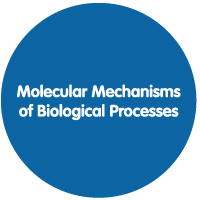 | | Chemical BiologyCoordinator
Carlos Romão
Ana Cecília Afonso Roque Objectives
The objective of this CU is to expose the students to a significantly broad, yet not exhaustive view of one of the methodological areas that has spurred many of the recent forward leaps of Biology, both in the ability to interrogate it and to manipulate its function. At the end of this CU students should have recognized and assimilated the new possibilities that emerge when biological problems are tackled by the articulate use of knowledge arising from different areas like synthetic and natural product chemistry, pharmacology, biochemistry and structural biochemistry. In this context, teaching is centered on some of the essential tools of Chemical Biology (CB) and its
objective is to form a way of thinking and researching Biology, which is crucial to consolidate at the entry of a PhD program.
From the vast area of real and conceptual aspects of CB this CU will focus on topics judged to have higher immediate impact and broader formative profile. Syllabus
1. Molecular recognition and binding
Analyzing molecular recognition and binding;
Biological molecular recognition studies.
2. Drug design, discovery and resistance
Therapeutic targets
Optimization of lead-target interactions
3. Chemical methods to synthesize DNA, RNA and applications in diagnostics and therapeutics
Solid phase oligonucleotide synthesis;
Incorporation of non-natural nucleotides;
siRNA and rybozymes.
4. Chemical methods to synthesize proteins and peptides
Solid phase peptide synthesis;
Native chemical ligation methods, inteins.
Incorporation of non-natural amino acids.
Protein design. Applications in diagnostics, therapeutics, proteomics.
5. Bioconjugates for in vivo and in vitro selection and screening
Biocompatible click reactions and bioorthogonal reactions.
Protein-drug conjugates, targeted medical imaging agents
6. Omics in chemical biology
Post-translational modifications and proteomics;
Chemogenomics
Metabolonomics Evaluation
The problem solving sessions will be used to provide a deeper analysis of actual problems and case studies, dissecting both their fundamental and experimental aspects. The students will receive such problems and case studies beforehand and will be called upon to present and discuss them during these sessions under the guidance and moderation of the lecturer. The evaluation of each student will be based on both the quality and intensity of his/her participation in such discussions. Main Bibliography - Miller, A. & Tanner, J. Essentials of Chemical Biology-Structure and Dynamics of Biological Macromolecules. Wiley VCH (2008)
- Waldmann, H. & Janning, P. Petra Chemical Biology: Learning through case studies. Wiley VCH (2009)
- Roque, A. C. A. Ed. Ligand Macromolecular Interactions in Drug Discovery. Humana Press (2010)
- Osada, H. Ed., Protein Targeting with Small Molecules, Wiley (2009)
- Blackburn, G.M. & Gait, M.J. Nucleic Acids in Chemistry and Biology. Oxford (1996) Branden, C. & Tooze, J.
- Introduction to Protein Structure. Garland (1999)
- Creighton, T.E. Proteins: Structures and Molecular Properties. Freeman (1993)
- Fersht, A. Structure and Mechanism in Protein Science. Freeman (1999)
|

